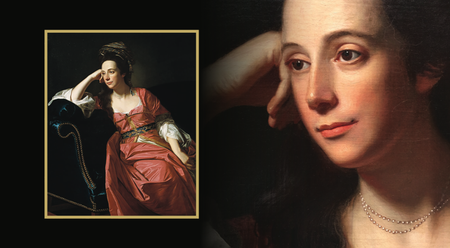Of the many memorable works in the Timken Museum of Art’s permanent collection, the portrait of Margaret Kemble Gage (Mrs. Thomas Gage) by John Singleton Copley is a favorite. Why?
The painter’s uncanny ability to describe the crisp folds in the woman’s satin, coral-colored robe as well as the intricacy of her fashionable hairstyle certainly confirm his role as Boston’s leading portraitist of the late colonial period. Copley enjoyed his reputation as a flashy painter and this one has its fair share of dazzle. Speaking personally, however, I have always been drawn to the look on Margaret Kemble Gage’s face. Perhaps, the attraction has something to do with the historical circumstances she faced. Gage’s husband, General Thomas Gage, was in charge of British military forces in North America. We also know that the Gages were in the midst of making plans for her to return to the safety of England. As rebellious acts increased and full-scale war seemed imminent, the 37-year-old wife of one of the most powerful military figures in North America took a break from packing up her home to sit and have a portrait made. While doing this, she appears poised, yet deep in thought. Her serene expression is beautiful, but also inscrutable. Margaret Gage can’t have known what the future would bring to her loved ones, or herself, in June of 1771, the moment that Copley began painting her. Nevertheless, she looks ahead with an attitude of confidence and determination. Almost 250 years after its creation, Mrs. Thomas Gage comes across as a representation of quiet courage in the face of uncertainty.
The painting reminds us how works of art can serve as models for seeking our best selves.
